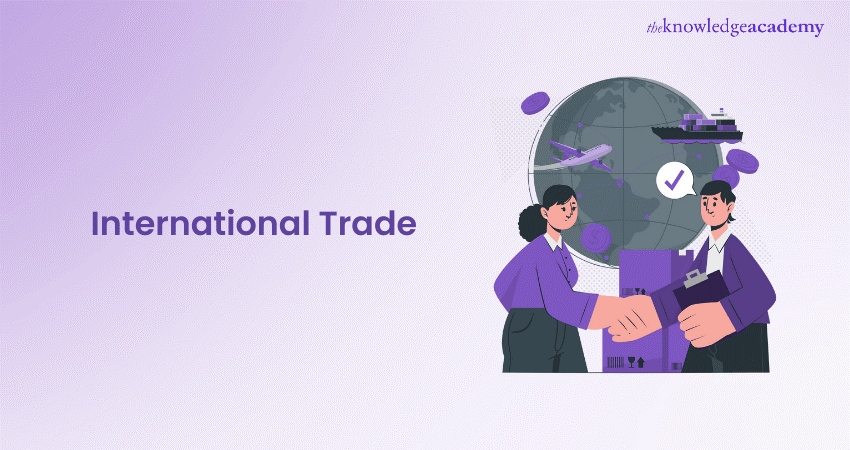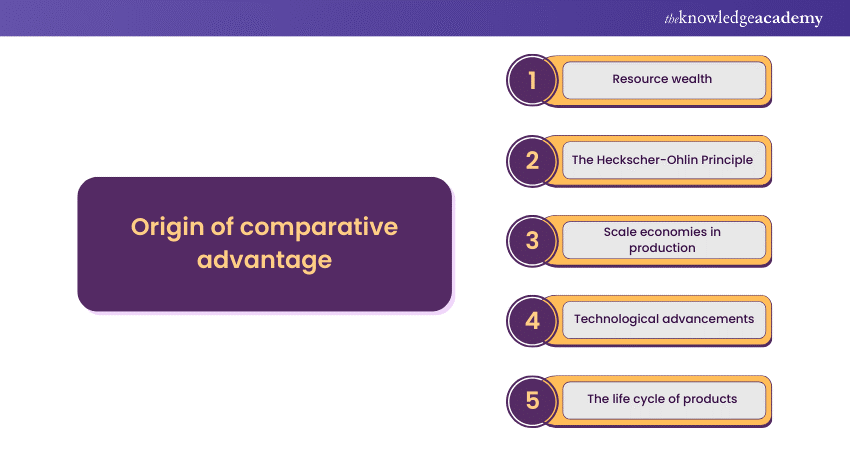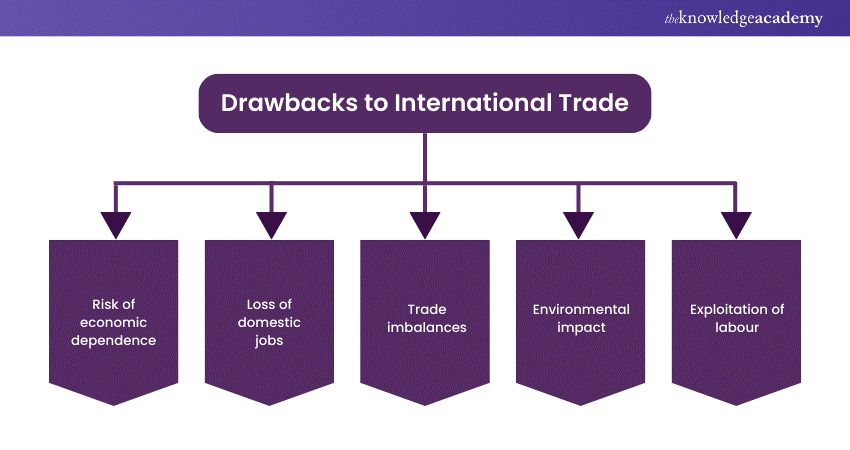We may not have the course you’re looking for. If you enquire or give us a call on + 1-866 272 8822 and speak to our training experts, we may still be able to help with your training requirements.
Training Outcomes Within Your Budget!
We ensure quality, budget-alignment, and timely delivery by our expert instructors.

If you are starting as a new entrepreneur or want to expand your business beyond your country, you need to be aware and know everything about International Trade. But what is International Trade? It can be defined as an intricate network of transactions which transcends borders, connects economies and fosters interdependence.
Are you planning to begin your journey in this form of business? If you are, remember the factors influencing this trade are tariffs, trade agreements, and geopolitical influences. In this blog, we will help you through this process and help you understand more about International Trade, its advantages, policies and more!
Table of Contents
1) Brief overview of International Trade
2) Understanding imports and exports
3) Define comparative advantage and its origin
4) Advantages of International Trade for a business
5) What are some drawbacks to International Trade
6) Examples of International Trade policies
7) Conclusion
Brief overview of International Trade
International Trade is a business where the exchange of services and goods occurs across borders. It plays a vital role in shaping the global economy. It also involves countries leveraging their comparative advantages to specialise in producing certain goods or services, promoting efficiency and economic interdependence. Factors like tariffs, trade agreements, and geopolitical considerations influence the mechanisms of International Trade.
Trade facilitates the flow of diverse products, creating access to a broader range of goods for consumers and opening markets for businesses. Moreover, it spurs economic growth by providing opportunities for nations to participate in the global marketplace. Understanding the complexities of International Trade is essential for policymakers, businesses, and individuals, as it impacts economic prosperity and plays a vital role in shaping diplomatic and geopolitical relations.
Understanding imports and exports
Imports, referring to goods and services a country acquires from foreign nations, play a pivotal role in satisfying domestic consumption needs and supplementing local production. Meanwhile, exports involve selling products and services to other countries, acting as a primary driver of economic growth by expanding market reach. The balance between imports and exports, known as the trade balance, holds significant financial implications.
Trade deficits or surpluses can impact currency values, employment rates, and economic stability. Analysing the nature of imports and exports provides insights into a nation's comparative advantages and areas of specialisation, influencing strategic financial decisions.
Enhance your knowledge of the current trends and policies with our Industry Training!
Define comparative advantage and its origin
Comparative advantage is an economic principle that denotes a country's ability to produce goods at a lower opportunity cost than another nation. It is an important concept in International Trade theory, emphasising efficiency and specialisation as driving forces behind global economic interactions.
Origin of comparative advantage
Now, let’s discuss the origin of comparative advantage:

1) Resource wealth
Comparative advantage originates in a country's abundance of natural resources. Nations endowed with rich resources, whether in minerals, agriculture, or energy, can produce certain goods more efficiently than others. This advantage stems from favourable conditions like fertile soil for agriculture, access to raw materials, or natural resource deposits, allowing these nations to specialise in producing specific goods and trade them for products they might not have as efficiently.
2) Factor endowments: The Heckscher-Ohlin Principle
The Heckscher-Ohlin Principle, a key component of comparative advantage theory, asserts that countries will specialise in and export goods that intensively use the factors of production they have in abundance. This concept ties into factor endowments, such as labour, capital, and land. For instance, a labour-abundant country might specialise in labour-intensive industries, while a capital-rich nation might focus on capital-intensive production. This specialisation increases efficiency and fosters trade based on each country's relative factor endowments.
3) Scale economies in production
Another source of comparative advantage arises from economies of scale. When a country can produce a particular good at a larger scale, the average cost of production decreases. This efficiency allows for cost-effective production, making the country more competitive globally. Economies of scale are particularly evident in industries where high production volumes lead to lower average costs per unit, giving nations with larger markets a comparative advantage in these sectors.
4) Technological advancements
Technological advancements contribute significantly to a country's comparative advantage. Nations at the forefront of technological innovation can produce goods more efficiently, often leading to higher-quality products at lower costs. Access to advanced technology allows countries to stay competitive by continuously improving production processes and creating innovative products. This advantage is dynamic, as staying technologically competitive requires ongoing investment in research and development.
5) The life cycle of products
The life cycle of products also plays a role in determining comparative advantage. As products move through their life cycles—introduction, growth, maturity, and decline—different countries may have benefits at different stages. For example, innovation and adaptability are crucial during the introduction and growth phases, and countries with advanced research capabilities may have a comparative advantage. In the maturity phase, cost efficiency becomes more critical, and countries with effective production processes and economies of scale may take the lead. Understanding the life cycle of products allows nations to position themselves in global markets strategically.
Advantages of International Trade for a business
Let’s discuss some advantages of International Trade for business:
Market expansion
a) International Trade opens new business markets, allowing individuals to reach a broader customer base beyond their domestic borders.
b) Access to a global market provides diverse opportunities for growth and revenue generation.
Increased revenue and profits
a) By tapping into international markets, entrepreneurs can increase their sales volume, leading to higher income.
b) The ability to sell services in multiple countries often translates into enhanced profitability.
Economies of scale
a) Engaging in International Trade allows businesses to benefit from economies of scale, especially in production and distribution.
b) Larger markets enable higher production volumes, leading to lower average costs per unit and increased efficiency.
Competitive advantage
a) Exposure to global competition encourages businesses to enhance their efficiency, quality, and innovation to stay competitive.
b) Companies that successfully navigate international markets often develop a competitive edge over those operating solely in domestic markets.
Diversification of risk
a) Operating in multiple markets helps businesses diversify their risks, as economic downturns or market-specific challenges in one country may be offset by positive conditions in others.
b) Diversification provides a buffer against localised economic or geopolitical uncertainties.
Access to specialised resources
a) International Trade allows businesses to access resources and raw materials that may not be available or cost-effective domestically.
b) This access also improves product quality and cost savings in the production process.
Cultural and technological exchange
a) International Trade fosters cultural exchange as businesses adapt their products and strategies to fit diverse cultural preferences.
b) Exposure to consumer needs and preferences encourages companies to improve and develop new products continuously.
Enhanced innovation
a) Global competition stimulates innovation as businesses strive to meet the demands of diverse markets.
b) Exposure to different consumer needs and preferences encourages companies to continuously improve and develop new products.
Trade agreements and reduced barriers
a) Participation in trade agreements can reduce tariffs and trade barriers, making it easier for businesses to enter and operate in foreign markets.
b) These agreements promote smoother cross-border transactions and create a more favourable business environment.
Brand recognition and reputation
a) Operating internationally can enhance a company's brand recognition and reputation.
b) Success in different markets can contribute to a positive image and increase consumer trust on a global scale.
Learn more about communicating effectively with our Facilitation Skills Training – register now!
What are some drawbacks to International Trade
Even though International Trade may seem like a lucrative business, we believe that before you invest yourself in this form of Trade, you must be aware of some of its cons so that you can be careful while you make important decisions or negotiations:

a) Risk of economic dependence: Excessive reliance on International Trade partners can make a country vulnerable to economic downturns in those partner nations. Economic interdependence can amplify the impact of global economic shocks.
b) Loss of domestic jobs: Increased international competition may lead to outsourcing jobs to countries with lower production costs, potentially causing unemployment and wage stagnation in the exporting country.
c) Trade imbalances: Persistent trade deficits or surpluses can lead to economic imbalances. Trade deficits may result in indebtedness, while surpluses may cause currency appreciation, affecting export competitiveness.
d) Environmental impact: International Trade can contribute to environmental degradation through increased transportation and industrial activity. Transporting goods across long distances may generate higher carbon emissions and other environmental consequences.
e) Exploitation of labour: Some countries may engage in unfair labour practices, taking advantage of lower labour standards in other nations. This can lead to concerns about worker exploitation and human rights violations.
Examples of International Trade policies
To help you understand the different sides of International Trade, let’s look at some of the examples of its policies:
1) Customs duties
Customs duties, or tariffs, are government taxes on imported or exported products. They are designed to raise revenue for the government and protect domestic industries by making imported goods more expensive. Governments set tariff rates based on the type of goods and their country of origin.
Tariffs can be specific (a fixed amount per unit) or ad valorem (a percentage of the product's value). Customs duties serve multiple purposes, including protecting domestic industries from foreign competition, regulating trade, and generating revenue for the government. However, high tariffs can lead to trade tensions and reduced efficiency in resource allocation.
2) Limits on imports
Limits on imports involve setting quotas or restrictions on the quantity of certain products and services that can be imported into a country. This is done to control the inflow of specific products and protect domestic industries. Quotas specify a maximum quantity of a particular product that can be imported within a given period.
Governments may also use licensing or permitting systems to control and monitor imports. Limits on imports aim to prevent flooding the domestic market with foreign goods, protect local industries from excessive competition, and ensure a balance between domestic production and imports. However, these measures can lead to reduced consumer choices and may be perceived as barriers to free trade.
Do you want to learn more about Import and Export? Sign up now for our Importing and Exporting Masterclass!
Conclusion
We hope you understood the basic concept of International Trade and why it is necessary to take your business beyond your country’s waters. In today’s world, it is a dynamic force shaping the global economy. It fosters economic interdependence, promotes efficiency through specialisation, and drives innovation.
Enhance your knowledge about managing Supply Chain – sign up now for our Supply Chain Management Training!
Frequently Asked Questions

Comparative advantage is crucial in International Trade because it allows countries to specialise in producing goods or services with lower opportunity costs. This efficiency promotes global trade, economic growth, and the optimal allocation of resources, benefiting all participating nations.

A trade deficit occurs when a country imports more products than it exports. While it may signal robust domestic demand, prolonged deficits can lead to indebtedness, loss of jobs in certain industries, and potential currency devaluation. However, trade deficits are not inherently negative and can be offset by other economic factors.

Tariffs, or taxes on imported goods, can impact International Trade by raising the cost of foreign products. While they aim to protect domestic industries, tariffs can increase consumer prices and reduce choices and trade tensions. Conversely, they may generate revenue for the government and incentivise domestic production.

The Knowledge Academy takes global learning to new heights, offering over 30,000 online courses across 490+ locations in 220 countries. This expansive reach ensures accessibility and convenience for learners worldwide.
Alongside our diverse Online Course Catalogue, encompassing 17 major categories, we go the extra mile by providing a plethora of free educational Online Resources like News updates, Blogs, videos, webinars, and interview questions. Tailoring learning experiences further, professionals can maximise value with customisable Course Bundles of TKA.

The Knowledge Academy’s Knowledge Pass, a prepaid voucher, adds another layer of flexibility, allowing course bookings over a 12-month period. Join us on a journey where education knows no bounds.

The Knowledge Academy offers various Industry courses, including Importing and Exporting Masterclass, Logistics Management Training, and Export and Trade Compliance Training. These courses cater to different skill levels, providing comprehensive insights into Logistics and its importance.
Our Industry Training blogs cover a range of topics related to Logistics, offering valuable resources, best practices, and industry insights. Whether you are a beginner or looking to advance your import and export skills, The Knowledge Academy's diverse courses and informative blogs have you covered.
Upcoming Business Skills Resources Batches & Dates
Date
 Import Export Course
Import Export Course
Fri 10th Jan 2025
Fri 14th Feb 2025
Fri 11th Apr 2025
Fri 23rd May 2025
Fri 8th Aug 2025
Fri 26th Sep 2025
Fri 21st Nov 2025







 Top Rated Course
Top Rated Course



 If you wish to make any changes to your course, please
If you wish to make any changes to your course, please


